Photography courtesy of Lowell Washburn, all rights reserved.
The pileated woodpecker is one of the most fascinating, though least seen, birds of the Iowa woodlands. Although always in high demand with birders, in depth observations do not come easy. During more than four decades of outdoor photography, I’ve only had opportunity to observe three active pileated nests. One of those rare events occurred this June at a nest in the heavily timbered Tanglefoot Area of Clear Lake’s south shore where, over an eight-day period, I was able to log nearly 100 hours of close hand observations of pileated adults and their young.
Although pileateds are best known for their raucous calls and high impact territorial bill hammering, the species also communicates through a vast array of complex vocalizations that most people will never hear – particularly at a nest site. The Tanglefoot nest site provided an educational crash course in the pileated dialect. From daylight to sunset, the adults rarely went more than a few minutes without communicating what they were up to with each other as well as with their nest bound youngsters.
When I first set up on the nest, I guessed the young [2 females and 1 male] to be around three weeks of age. On average, the youngsters were fed about once every 50 minutes with the feedings evenly divided among the adults. Following each feeding, the male would enter the nest where he collected and removed a youngster’s fecal sack; carrying the waste out of sight and keeping the nest’s interior cleaner than most restrooms. An obvious responsibility of the male, the female never carried away any of the nestling’s waste.
Nearly 100 percent of the parents’ deliveries were comprised of eggs, larvae, or adult carpenter ants. On two occasions, I was able to get close enough to foraging adults to observe their behavior. In both instances, the birds were on the ground gleaning from ant infested, fallen logs. Three-inch wood chips flew as the birds got down to business. By the time the excavations were finished, the wreckage was nearly as complete as if the log had been visited by foraging bears.
At first, the young were mostly seen as parents arrived with food. But as the youngsters grew larger, and the cavity more crowded, they spent more and more time competing for “window space” at the nest entrance. The young also grew increasing vocal with each passing day, not just when begging for ants, but as a means of frequent communication with adults who often responded to their inquiries from more than a hundred yards away.
By the time the young were ready to fledge, they were virtual carbon copies of their parents. The babies even had the diagnostic red or black facial ‘sexing stripe’ of the adults, which is how I knew there were 2 females and 1 male. The only apparent difference between adults and young was that the youngsters had black eyes rather than the amber iris of their parents.
During the last three days in the nest, I expected the young to test their wings at any moment. By now, at least one of the young was always at the door and they never shut up – a development that may have been alarming to adults hoping to the keep the site inconspicuous to predators such as raccoons, horned owls or Cooper’s hawks.
Both adults showed significant changes in behavior during the young’s final 48 hours in the nest. Both parents became noticeably less vocal and the female suddenly assumed the majority of feedings; visiting the nest at least five times to the male’s one. Although feedings occurred more frequently now, the female appeared to be feeding the young less per meal. When the male did bring food, he left without removing waste – I interpreted this to be a sign that the young were about to leave home. I desperately wanted to see at least one of the youngsters take its initial flight. I couldn’t find anyone who had actually witnessed the event and I didn’t know what to expect. Would the bird successfully fly to a nearby tree, or would it crash land on the woodland floor?
The young finally fledged on what I estimated to be 29 or 30 days of age. The females were the first to go; and watching over them became the adult male’s full-time job. Although obviously anxious, the young male refused to budge and was still in the nest at mid-afternoon – more than six hours since his sisters had made the leap.
Saving the Best for Last: In spite of the delay, the male’s last couple of minutes at the nest were most entertaining. Upon arriving at the cavity with a full load of plump ant eggs, the female only allowed the baby to take one small bite before withdrawing the offering. Screaming like a banshee, the male elevated his red crest and vigorously begged for more. The female responded with loud, upslurred cooings, but would not return. Instead she retreated, tree by tree, deeper into the woodland; all the while encouraging the baby to follow.
It appeared to be just another dry run until the male suddenly decided to take the bait. Leaping from the confines of the nest cavity, the fledgling launched from the entrance and took flight. But instead of trying for the nearest tree, the baby seemed convinced that he could make it all the way to his mother. What occurred next, was hard to believe. Without the least sign of faltering, the male flew directly through the woods toward the sound of its mother – disappearing from view more than 80 yards from the nest – an incredible feat for a bird that had never been able to even open its wings until this very moment.
My wife, Carol was also at the site and — “Did you see that?” — was our simultaneous response to the baby’s debut flight. Although we immediately tried to relocate the male and its mother, we were never able to see or hear any of the young or either of adult again – typical behavior for the nests I’ve seen. With the much-anticipated Main Event now concluded, the woodland seemed sadly quiet.
LW

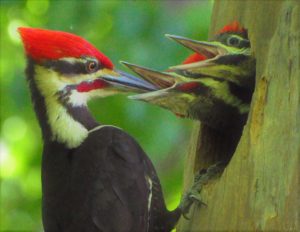
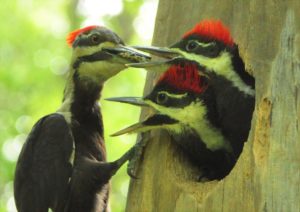
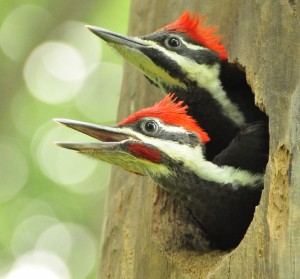
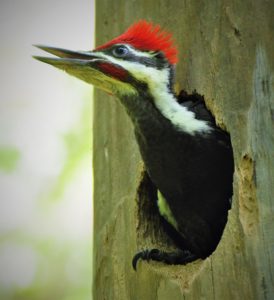
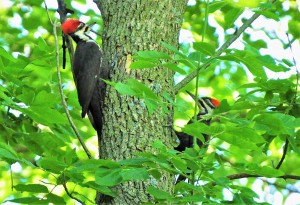
 Tom Cope
Tom Cope Sue Wilkinson
Sue Wilkinson Susan Judkins Josten
Susan Judkins Josten Rudi Roeslein
Rudi Roeslein Elyssa McFarland
Elyssa McFarland Mark Langgin
Mark Langgin Adam Janke
Adam Janke Joe Henry
Joe Henry Kristin Ashenbrenner
Kristin Ashenbrenner Joe Wilkinson
Joe Wilkinson Dr. Tammy Mildenstein
Dr. Tammy Mildenstein Sean McMahon
Sean McMahon